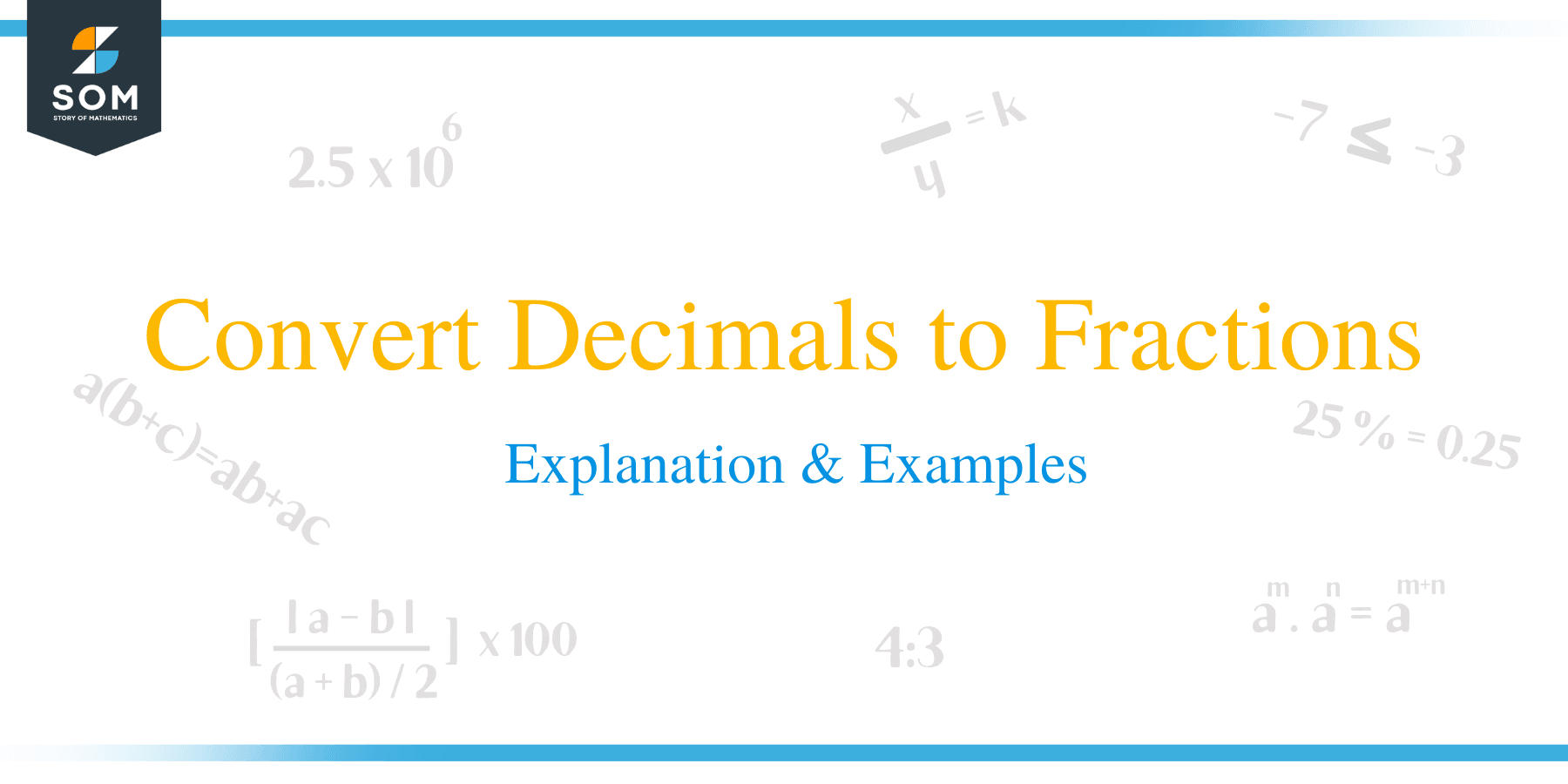- Home
- >
- Convert Decimals to Fractions – Explanation & Examples
Convert Decimals to Fractions – Explanation & Examples
 Before we learn how to convert decimals to fractions, there are a number of basic information we need to know about decimals and fractions. To start with, a decimal number is probably a number which has a dot (.) between the digits, this dot is known as a decimal point. Basically, decimal numbers are just fractions having a denominator expressed in power of 10. Example of decimal numbers are: 0.005, 3.2, 10.9, 55.1, 1.28, 9.234, etc.
Before we learn how to convert decimals to fractions, there are a number of basic information we need to know about decimals and fractions. To start with, a decimal number is probably a number which has a dot (.) between the digits, this dot is known as a decimal point. Basically, decimal numbers are just fractions having a denominator expressed in power of 10. Example of decimal numbers are: 0.005, 3.2, 10.9, 55.1, 1.28, 9.234, etc.
A fraction on the other hand is portion of a whole number usually denoted as a ratio of two integers a/b. The two integers a and b are referred to as the numerator and denominator respectively. There are three types of fractions namely: Proper, Improper and Mixed fraction. Examples of fractions are, 5/8, 7/3 and 2 1/5.
How to Convert Decimal to Fraction?
We can easily convert a decimal number into a fraction by following simple steps and no calculators are required. This article has elaborated clearly all the steps of converting decimals to fractions, with some examples.
Let us learn these steps on to convert the decimal into fractions:
- First, begin by counting the numbers to the right side after the decimal point.
- Let n be the number of digits on the right side after the decimal point.
- Write the number without a decimal point as a numerator and the power of 10 n as the denominator
- Now the fraction can be simplified by reducing the denominator and numerator with a common factor.
- The simplified fraction is the required fraction from the given decimal number.
Let us solve the following examples so get a better understand of how to convert a decimal into fraction.
Example 1
Convert 0.7 to a fraction.
Solution
- The number 0.7 has only one decimal place, therefore our n is 1.
- Take the number as a numerator by ignoring the decimal point. Take also the power of 101 as the denominator.
- Now our fraction is 7/ 101. And since 101 = 10, then our fraction is 7/10.
- The fraction is already in its lowest terms, therefore, 7/10 is our answer.
Example 2
Convert 0.05 to a fraction and simplified it in the lowest form.
Solution
- The number 0.05 contain two decimal places, therefore n = 2.
- Ignore the decimal point and write the number as the numerator and take also 10 2 to be the denominator
- Since 10 2 is the same as 10 x 10 = 100, the write the number in fractional form: 5/100.
- Because the both the numerator and denominator have a common factor, then the fraction can be simplified to the lowest terms: 5/100 = 1/20
- Therefore, the answer is 1/20
Example 3
Convert the decimal number 5.066 into a fraction.
Solution
- First count the number of decimal places. The number of decimal places in 5. 066 is 3. Therefore, n = 3
- Write the decimal as a whole number and divide it by 10 3. You can notice that dividing the number is the same as writing it in fractional form.
- Since 10 3 = 10 x10 x 10 = 1000, Now the number in fractional form is 5066/1000.
- By just looking at the last digits both the numerator and denominator, the numbers are even.
- Simplify the fraction: 5066/1000 = 2533/500
- The fractional can not be simplified further, and hence the answer is 2533/500
Example 4
Convert 0.0035 into fraction
Solution
- In this case, the number of decimal places in the number is 4. Therefore, n = 4.
- Write the number without a decimal point and divide by 10 4 =10 x 10 x 10 x 10 = 10000
- 0035 = 35/10000. Both the denominator and numerator have common factors, therefore simplify the fraction to its lowest form.
- 35/10000 = 7/2000.
- Thus, the answer is 7/2000.

How to Convert a Repeating Decimal to Fraction?
Repeating or recurring numbers are decimal numbers with the endless repeating decimal digits. Either there can be a single digit repeating or two and more digits repeating by alternating. Examples of repeating numbers are: 0.3333333…., 0.666…, 4.2525252525…, 0. 56111., etc.
To convert a repeating number into a fraction, see the following example.
Example 5
Convert the repeating number 0.6666… Into fraction.
Solution
Let r be the repeating number: r = 0.6666
Multiply both sides of the multiplication sentence by 10.
10 x = 6.666…
Perform the subtract on both sides of the equation as shown below;
(10x – x) = (6.6666 – 0 .666)
9x = 6.000
Now divide both sides by 9;
x = 6/9
Simplify the fraction to its lowest terms
x = 6/9 = 2/3
Hence, 0.6666…= 2/3
Therefore 2/3 is fraction from a recurring number 0.6666666…..

